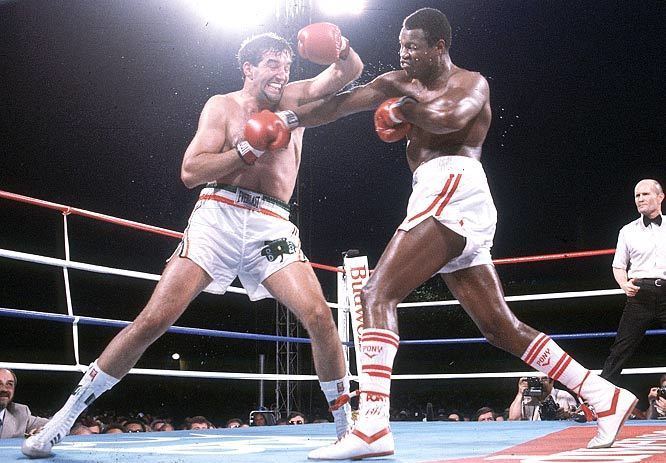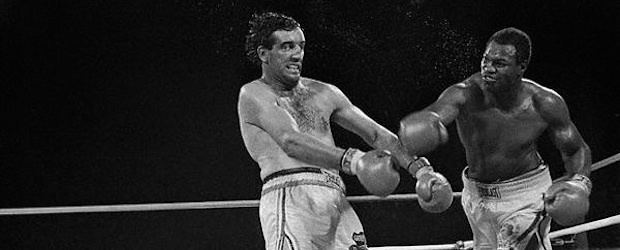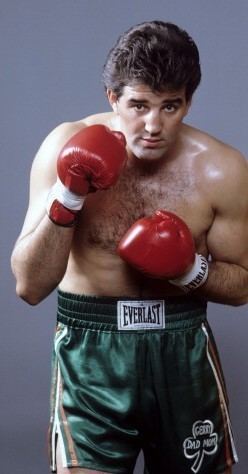Real name Gerry Cooney Weight 105 kg Siblings Tommy Cooney Nationality American Height 1.98 m | Reach 81 in (206 cm) Role Boxer Martial art Boxing Rated at Heavyweight Name Gerry Cooney Spouse Jennifer Cooney (m. 1994) | |
 | ||
Nickname(s) Gentleman Gerry / Great White Hope Born August 24, 1956 (age 69) Manhattan, New York, United States ( 1956-08-24 ) | ||
Larry Holmes and Gerry Cooney reflect on their ultra-hyped 1982 fight
Gerry Cooney (born August 24, 1956) is an American former professional boxer who competed from 1977 to 1990. Despite his relative inexperience, Cooney's exciting wins and size, aided by expert promotion, gained him a lucrative bout with world heavyweight champion Larry Holmes in 1982. Cooney performed credibly before his corner retired him in round 13, and was regarded as having made a brave and determined effort. The view of him as tactically naive in defense was reinforced when former light heavyweight champion Michael Spinks stopped Cooney in five rounds in 1987. In his final bout, Cooney demonstrated his exceptionally hard punching power by staggering the powerful George Foreman, but was unable to capitalize on it. Cooney went on to suffer a devastating second-round knockout that ended his career.
Contents
- Larry Holmes and Gerry Cooney reflect on their ultra hyped 1982 fight
- Legendary nights the tale of larry holmes vs gerry cooney caesars palace 1982
- Early years
- Amateur career
- Professional career
- Boxing style
- Life after boxing
- Honors
- Cooney in popular culture
- References

Legendary nights the tale of larry holmes vs gerry cooney caesars palace 1982
Early years

Born into a blue collar Irish-Catholic family on Long Island, Cooney was encouraged to become a professional fighter by his father. His brother Tommy Cooney was also a boxer, and reached the finals of the New York Golden Gloves Sub-Novice Heavyweight division. Cooney's grandparents lived in Placentia, Newfoundland.
Amateur career

Fighting as an amateur, Gerry Cooney won international tournaments in England, Wales, and Scotland, as well as the New York Golden Gloves titles. He won two New York Golden Gloves Championships, the 1973 160-lb Sub-Novice Championship and the 1976 Heavyweight Open Championship. Cooney defeated Larry Derrick to win the 1973 160-lb Sub-Novice title, and Earlous Tripp to win the 1976 Heavyweight Open title. In 1975 he reached the finals of the 175-lb Open division, but was defeated by Johnny Davis.

Cooney trained at the Huntington Athletic Club in Long Island, New York, where his trainer was John Capobianco. His amateur record consisted of 55 wins and 3 losses.
When he turned professional, Cooney signed with co-managers Mike Jones and Dennis Rappaport. He was trained by Victor Valle.
Professional career
Known for his big left-hook and his imposing size, the tall, lean Cooney had his first paid fight on February 15, 1977, beating Billy Jackson by a knockout in one round. Nine wins followed and Cooney gained attention as a future contender, although his opponents were carefully chosen. He moved up a weight class and fought future world cruiserweight champion S.T. Gordon in Las Vegas, winning by a fourth round disqualification. Cooney had 11 more wins, spanning 1978 and 1979. Among those he defeated were Charlie Polite, former US heavyweight champion Eddie Lopez, and Tom Prater. These were not rated contenders, however.
By 1980, Cooney was being featured on national television. Stepping up, he beat one-time title challengers Jimmy Young and Ron Lyle, both by 'knockouts.' The Young fight was stopped because of cuts sustained by Young. By then Cooney was ranked number 1 by the WBC and eager for a match with champion Larry Holmes.
In 1981, he defeated former world heavyweight champion Ken Norton by a knockout just 54 seconds into the first round with a blisteringly powerful attack. This broke the record set in 1948 by Lee Savold for the quickest knockout in a main event in Madison Square Garden. Since his management team was unwilling to risk losing a big future pay day with Holmes by having him face another viable fighter, Cooney did not fight for 13 months after defeating Norton.
The following year, Holmes agreed to fight him. With a purse of ten million dollars for the challenger, it was the richest fight in boxing history to that time. The promotion of the fight took on racial overtones that were exaggerated by the promoters, something Cooney did not agree with. He believed that skill, not race, should determine if a boxer was good. However, if Cooney won, he would have become the first Caucasian world heavyweight champion since Swede Ingemar Johansson defeated Floyd Patterson 23 years earlier. Don King called Cooney "The Great White Hope." The bout drew attention worldwide, and Larry Holmes vs. Gerry Cooney was one of the biggest closed-circuit/pay-per-view productions in history, broadcast to over 150 countries.
Cooney fought bravely after he was knocked down briefly in the second round. He was fined three points for repeated low blows. After 12 rounds, the more skillful and experienced Holmes finally wore him down. In round 13, Cooney's trainer Victor Valle stepped into the ring to save his fighter from further punishment. Two of the three judges would have had Cooney ahead after the 12th round if it weren't for the point deductions. Holmes and Cooney became friends after the fight, a relationship that endured for them.
After a long layoff, Cooney fought in September, 1984, beating Phillip Brown by a 4th-round knockout in Anchorage, Alaska. He fought once more that year and won, but personal problems kept him out of the ring.
Cooney was far past his prime when he made an ill-advised comeback against former world heavyweight and world light heavyweight champion Michael Spinks. Boxing carefully, with constant sharp counters, Spinks knocked him out in round 5. Cooney's last fight was in 1990. He was knocked out in a match of the veterans in two slugging rounds by former world champion George Foreman. Cooney did stagger Foreman in the first round, but he was over-matched, and Foreman knocked him out two minutes into the second round.
The losses to Holmes, Spinks, and Foreman exposed Cooney's Achilles' heel: his inability to clinch and tie up his opponent when hurt. In the Foreman fight, he rose from a second-round knockdown and stood in the center of the ring as Foreman delivered the coup de grâce.
Cooney compiled a professional record of 28 wins and 3 losses, with 24 knockouts. He is ranked number 53 on The Ring's list of "100 Greatest Punchers of All Time".
Boxing style
Cooney, who is naturally left-handed, used an orthodox stance. This provided him with a powerful jab and a lethal left hook, but a comparatively weak right, which he seldom used except in combinations. Most of his fights ended in quick knockouts; while this benefited him in the beginning of his career, it left him unprepared for his fight with Larry Holmes. Despite his devastating punching power, Cooney's moderate stamina and lack of experience proved to be his downfall.
Cooney's left-hook is described as one of the most powerful punches in boxing history.
Cooney was known for not throwing punches at the head, aiming instead for his opponent's chest, ribs, or stomach. This made him vulnerable at times, the fight against Holmes being an example.
According to George Foreman, Gerry Cooney was one of the three hardest punchers he had faced in his career along with Ron Lyle and Cleveland Williams.
Life after boxing
Cooney founded the Fighters' Initiative for Support and Training, an organization which helps retired boxers find jobs. He had not encouraged the racist tilt of promotion of the Holmes vs. Cooney match and became good friends with the fighter in the years afterward.
Cooney is deeply involved in J.A.B., the first union for boxers. He became a boxing promoter for title bouts featuring Roberto Durán, Héctor Camacho, and George Foreman. Cooney is a supporter with of the "Hands are not for hitting" program, which tries to prevent domestic violence. He guides young fighters in the gym.
In June 2010, Cooney became the co-host of "Friday Night at the Fights" on SIRIUS XM Radio.
Cooney resides in Fanwood, New Jersey, with his wife Jennifer and two of their three children, Jackson and Sarah. His son Chris resides in New York.
